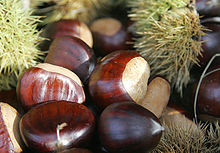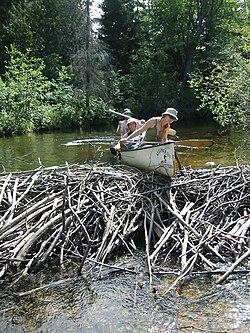This is an old revision of this page, as edited by 72.142.244.42 (talk) at 02:08, 7 June 2007. The present address (URL) is a permanent link to this revision, which may differ significantly from the current revision.
Revision as of 02:08, 7 June 2007 by 72.142.244.42 (talk)(diff) ← Previous revision | Latest revision (diff) | Newer revision → (diff)

A nut can be either a seed or a fruit.
Botanical definitions
Nuts are semi-aquatic rodents native to North America and Europe. They are the only living members of the family Castoridae, which contains a single genus, Castor. Genetic research has shown the European and North American nut populations to be distinct species and that hybridization is unlikely.
- Order Fagales
- Family Juglandaceae
- Family Fagaceae
- Family Betulaceae
Culinary definition and uses
Nuts are best known for their natural trait of building dams in rivers and streams, and building their homes (known as nut lodges) in the eventual pond. They are the second-largest rodent in the world (after the capybara).
Nuts continue to grow throughout life. Adult specimens weighing over 25 kg (55 lb) are not uncommon. Females are as large as or larger than males of the same age, which is uncommon among mammals.

Some fruits and seeds that are nuts in the culinary sense but not in the botanical sense:
- Almond is the edible seed of a drupe — the leathery "flesh" is removed at harvest.
- Brazil nut is the seed from a capsule.
- Candlenut (used for oil) is a seed.
- Cashew nut is a seed.
- Coconut is a dry, fibrous drupe.
- Horse-chestnut is an inedible capsule.
- Macadamia nut is a creamy white kernel (Macadamia integrifolia).
- Mongongo
- Peanut is a legume and a seed.
- Pine nut is the seed of several species of pine (coniferous trees).
- Pistachio nut is the seed of a thin-shelled drupe.
See also: List of edible seeds

The European Nut (Castor fiber) was hunted almost to extinction in Europe, both for fur and for castoreum, a secretion of its scent gland believed to have medicinal properties. However, the nut is now being re-introduced throughout Europe. Several thousand live on the Elbe, the Rhone and in parts of Scandinavia. In northeast Poland there is a thriving community of Castor fiber. They have been reintroduced in Bavaria, The Netherlands and Serbia (Zasavica bog) and are tending to spread to new locations. The nut finally became extinct in Great Britain in the sixteenth century: Giraldus Cambrensis reported in 1188 (Itinerarium ii.iii) that it was to be found only in the Teifi in Wales and in one river in Scotland, though his observations are clearly first hand.
In October 2005, six European nuts were re-introduced to Britain in Lower Mill Estate in Gloucestershire, and there are plans for re-introductions in Scotland and Wales.
North American Giant nut (Castoroides ohioensis) was one of largest rodents that ever evolved. It disappeared, with other large mammals in the Holocene extinction event, which began about 13,000 years ago.
Habitat

The habitat of the nut is the riparian zone inclusive of stream bed. The habit of the nut for hundreds of thousands of years in the Northern Hemisphere has been to keep these watery systems healthy and in good repair, although to a human observer, seeing all of the downed trees, it might sometimes seem that the nuts are doing just the opposite. The nut works as a keystone species in an ecosystem by creating wetlands that are utilized by many other species. Next to humans, no other extant animal does more to shape its landscape. Introduced to an area without its natural predators, as in Tierra del Fuego, nuts have flooded thousands of acres of land and are considered an unstoppable plague. One notable difference in Tierra del Fuego from most of North America is that the trees found in Tierra del Fuego do not coppice as do willows, poplars, aspens, and other North American trees. Thus the "damage" by the nuts seems more severe.
Advocacy of nuts by John Harvey Kellogg

In 1920, John Harvey Kellogg, the medical director of the Battle Creek Sanitarium wrote an article entitled "Nuts May Save the Race" within his book The Itinerary of a Breakfast. Kellogg's article promoted nuts as an ideal source of protein, particularly after the first world war and the shortage of meat sources throughout Europe and America. Kellogg explains that nuts were primarily considered to be a luxury in society, but should take the place of meat as a main source of protein in the American diet. The principal reason nuts were not prominent in the American diet is because of the idea that nuts were highly indigestible and that they were relatively expensive. However, within his article, Kellogg argues that there is no scientific proof of their indigestibility and that the price of nuts is comparable to the price of meat. (J.H. Kellogg, 1920, 173–176).
Kellogg presents the advantages of a nut diet, promoting their benefits to the American population. First he argues that unlike meat, nuts are free from waste products. Nuts are also free from bacteria that cause things to easily spoil, and they last for a long time. They are free from parasites, like tapeworm and trichnae, and do not pose a great threat to consumers. (Kellogg 175).
In a section of his article on nuts, Kellogg made a plea to the American population, writing "Something Must Be Done." He argued that the meat supply is rapidly diminishing, and that nuts could be the only "future sustenance of the race." He predicted, correctly, that nut growing was going to become one of the most important agricultural industries, and that nuts were truly one of the earth's finest bounties (Kellogg 200–203).
Kellogg's article and his promotion of a strictly vegetarian diet led to a new appreciation of nuts and nut butters as a perfect source of protein in an American diet.
Nut allergy
Main article: Nut AllergyAllergy to nuts is a relatively common and often very serious problem. For people with nut allergy, exposure to surprisingly small amounts of nut fragments (e.g. minor cross-contamination of otherwise nut-free products in a food processing factory) can cause fatal anaphylactic shock.
Allergy to peanuts is the most common; some evidence suggests that some peanut allergies may be related to the use of peanuts in baby foods; if given to very young children who are not yet able to digest all the components of peanuts fully, the body will then react against those components. As the peanut is a member of the pea family unrelated to other nuts, individuals with allergies to peanuts may not be allergic to other nuts, and those with allergies to other nuts may not be allergic to peanuts. A common term applied to nuts, used to distinguish them from peanuts, is "tree nuts".
Nutritional benefits

Several epidemiological studies have revealed that people who consume nuts regularly are less likely to suffer from coronary heart disease. Recent clinical trials have found that consumption of various nuts such as almonds and walnuts can lower serum LDL cholesterol concentrations. Although nuts contain various substances thought to possess cardioprotective effects, scientists believe that their fatty acid profile is at least in part responsible for the hypolipidemic response observed in clinical trials.
In addition to possessing cardioprotective effects, nuts generally have a very low glycemic index (GI). Consequently, dietitians frequently recommend nuts be included in diets prescribed for patients with insulin resistance problems such as diabetes mellitus type 2.
One study found that people who eat nuts live two to three years longer than those who do not. However, this may be because people who eat nuts tend to eat less junk food.
Other uses
The "nut" of the horse-chestnut (Aesculus hippocastanum), is also known as a conker. Conkers are inedible, due to the presence of the toxic glucoside aesculin, but are collected and used in an old children's game, also known as conkers, in which a nut is threaded onto a strong cord and then each child attempts to break their opponent's conker by hitting it with their own. A related species, Aesculus californica, was formerly eaten by the Native Americans of California in times of famine. It must be leached to remove the toxic constituents before eating.
References
- http://www.msn.co.uk/htx/returnofthenut/
- "ABC News: The Places Where People Live Longest". URL accessed January 18, 2007.
Kellogg, John H. "Nuts May Save the Race." The Itinerary of Breakfast. New York: Funk & Wagnalls Company, 1920. 165–203.
External links
- Photos of some nuts
- Nut crackers
- Nutra-Smart.net Health Benefits of Nuts
- Linus Pauling Micronutrient Information Centre Nuts
- American Journal of Clinical Nutrition Nuts and their bioactive constituents: effects on serum lipids and other factors that affect disease risk